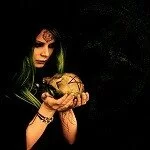 In ancient cultures, there was no special distinction between religion and magic. People sincerely believed that everything in the world was run by light and dark spirits or deities. To appease the gods, magicians performed many different magical actions.
In ancient cultures, there was no special distinction between religion and magic. People sincerely believed that everything in the world was run by light and dark spirits or deities. To appease the gods, magicians performed many different magical actions.
Magicians
Magic was supposed to be divided into three main types: black, white, and gray. Black magic was able to harm people and was considered the fate of evil wizards. White magic, on the contrary, protected a person from evil forces and was practiced by good witches. Finally, the gray one was a cross between white and black magic.
The regular sorcerer in the primitive tribe was a very respected and influential person. He cured diseases, caused rain in a drought, drove the beast into the hands of hunters with a spell, punished guilty tribesmen, etc. The sorcerer usually passed on his knowledge of magic by inheritance to a chosen disciple.
When Christianity arose, magic lost its widespread influence and was considered a “diabolical” doctrine because it interfered with the essence of nature, violating the will of divine forces. It was believed that the one who resorted to magic action, calls to his helpers the servants of Satan. So began the famous” witch hunt ” of the Middle Ages.
Witches
In our time, the concept of “witch” has a completely different meaning than it was given in ancient times. A witch – one who knows, knows the essence of things. This is a whole layer of lost cultural tradition.
The infamous treatise “the Hammer of witches” was written in 1486 by the inquisitors Jacob Sprenter and Henry Institoris. It served as a practical guide to recognizing witches for many years.
It describes in detail the regularity with which witches gather for the Sabbath. There were so-called monthly covens held by small groups of witches. Major sabbaths were held, as we would now say – every quarter (February 2, June 23, August 21, December 21).
The most significant sabbaths were held twice a year: on April 30 (Walpurgis night) and on the night from October 31 to November 1 (all saints ‘ eve).
It was also believed that every witch could fly by preparing a special herbal ointment and smearing her body with it. Therefore, the witches always came to the Sabbath in the Nude. However, in the 16th century, the doctor Johann weier suggested that this ointment had only a narcotic effect on witches. They only imagined that they were flying, but in reality the witches were only getting strong hallucinations.
The Middle Ages were marked by the mass burning of witches and wizards at the stake of the Inquisition. At best, a man accused of witchcraft would be hanged or drowned.
The most famous and terrible story occurred in the “city of witches” Salem (Massachusetts) in 1692. Here more than forty women were accused of witchcraft and then put to death.
Shamans
Magic includes any activity related to divination, witchcraft, or sorcery. True high-level magic experts were not only able to perform ordinary miracles, but were also able to penetrate other dimensions. They could easily manipulate their reality. Such unique specialists include shamans.
The word “shaman” from even translates as “expert”, “Witcher”. In Altai, such a person is called “Kam”, and in Kazakhstan and Kyrgyzstan – it is “Bakshi”. In Mongolia and Buryatia – “bee”. Shamans can talk to spirits.
Shamans, in order to influence reality in one way or another with the help of special magic rituals, use bioenergetic forces. They were able to cure any disease. They could send terrible misfortunes to people they did not like, including fatal illnesses. At will, the shaman could separate the soul from his own body and send it to the other world, thereby maintaining a connection between living people and their dead ancestors.
To perform the magic rite, the shaman dresses up in special clothing. Among the backgammons of Siberia, this was usually a long shirt made of deer or seal skins, which was worn over the trousers. The shaman attaches various magical attributes to his clothing: figures of animals and people, bells, sticks, ribbons, strips of skin, etc.
The shaman uses a tambourine or drum to put himself into a trance. Some peoples, such as the Eskimos and South American Indians, use rattles to enter into trance.
Sixth sense
Researchers believe that the use of magic by individuals is related to their innate ability to perceive and feel the bioenergoinformational field, other people, physical objects and the environment. The modern designation for such a person is psychic, which means “hypersensitive”. These are people who have a pronounced “sixth sense”, which is often associated with clairvoyance (the ability to obtain information about the future and the past).
The ability to extrasensory perception can be developed by special exercises and trainings. In fact, we can all become magicians if we focus our attention on the inner world and reject the harmful effects of external factors.